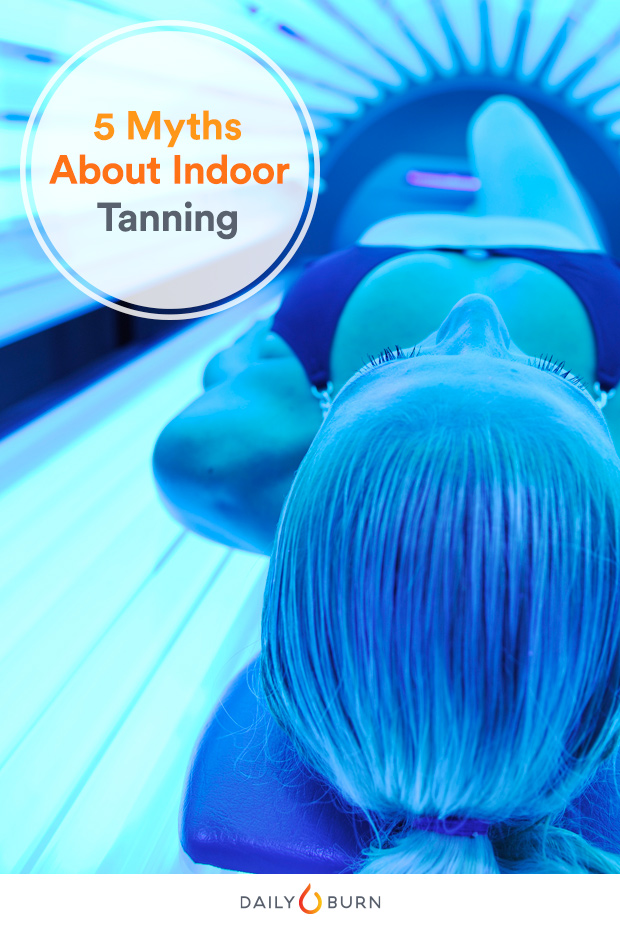
You rounded up your friends, booked the flights, and packed your new swimsuit. Now you just need to hit the salon so you don’t show up at the beach looking pasty… right? Well, wait a second: Even though more than a million Americans per day partake in indoor tanning, joining their ranks is a risky move. Surely you’ve heard that fake baking causes skin cancer, but maybe you’re not totally convinced — or you could be buying into some common misconceptions about the practice. Read on for the facts so you can safeguard your health — and your looks.
RELATED: 10 Ways You’re Using Sunscreen All Wrong
5 Big-Time Indoor Tanning Myths
You’ve heard: “A base tan protects against burning.”
Reality: The idea that getting a little color now will stop you from burning later is one of those myths that just won’t go away. “A tan — whether it comes from a UV lamp or natural sunlight — only confers an SPF of 4,” which isn’t high enough to prevent a sunburn, says Kavita Mariwalla, M.D., assistant clinical professor of dermatology at SUNY at Stony Brook. The best way to avoid turning the color of a lobster is, you guessed it, to skip the intentional tanning and wear sunscreen. Pick a broad-spectrum product with an SPF of at least 30. A wide-brimmed hat and sunglasses are musts as well, says Mariwalla.
You’ve heard: “Indoor tanning beds are safer than the sun’s rays.”
Reality: UV light that’s strong enough to cause pigment changes in your skin is dangerous, period. Plus some sunlamps deliver a dose of radiation that’s substantially stronger than what you’d get from natural light. It’s also worth noting that people do get burned at tanning salons — and each year 1,800 of them are injured badly enough to end up in the emergency room, according to the Centers for Disease Control and Prevention.
RELATED: Vitamin D Deficiency: What You Need to Know
You’ve heard: “Tanning is only a problem if you do it often.”
Reality: “Just one indoor tanning session increases the risk of developing melanoma by 20 percent,” says Mariwalla. Even more frightening: “If you’re younger than 35 and have been going to tanning beds, your lifetime risk of developing melanoma increases by as much as 90 percent,” she says. The trouble stems from a concentrated dose of UV radiation, which damages the DNA of skin cells.
You’ve heard: “Skin cancer is easily cured.”
Reality: It’s true that there are different types of skin cancer, and they’re not equally deadly. But melanoma — which can be fatal— is the most common form of cancer diagnosed in young adults age 25 to 29. While several factors (including genetics) may play a role, about 86 percent of melanomas are directly linked to UV exposure. One person dies of melanoma every hour, according to the American Cancer Society.
RELATED: 5 Reasons to Invest in New Shades
You’ve heard: “Everyone looks better tan.”
Reality: A recent study from the University of North Carolina School of Medicine found that many college-age women are continuing to visit tanning salons despite knowing the risks, mainly because they like how it makes them look. Whether darker skin is more attractive is a matter of opinion, but one thing is certain: No one wants premature wrinkles, age spots and fine lines — and UVA rays (which come from the sun as well as from tanning beds) are responsible for these signs of aging. If you’re determined to sport a golden glow, reach for a bottle of bronzer or get a professional spray tan. “Even though I tell patients ‘pale is the new tan,’ I love self-tanners,” says Mariwalla.
To find more information about the dangers and risks of indoor tanning head to The Skin Cancer Foundation and the American Academy of Dermatology.
Originally posted on March 26, 2014. Updated June 2016.
